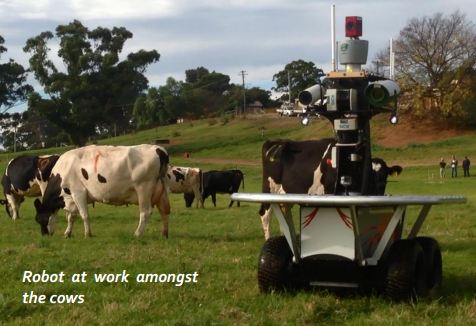



Robot Amongst the Herd: A Pilot Investigation of Behavioural Response in Cattle
The adaptability of cattle has been assessed by a study at the University of Sydney, indicating that cattle can become used to the most radical technology.Cameron Clark of Sydney University writes, it is widely recognised that technology has a vast role to play in helping Australia’s farmers reduce the time spent on repetitive tasks. Mr Clark added that this would increase the attraction and retention of employed labour in the industry and provide and act on data to increase farm productivity to sustainable levels.
The continuous monitoring and movement of livestock between areas defined for grazing or from these areas to procedural locations (i.e. yards, dairy facility) is a repetitive task that is ideally suited to automation.
A pilot study conducted at the University of Sydney’s dairy research farm in Camden determined the behavioral response of dairy cows to an unmanned ground vehicle (UGV) across time.
Picture Courtesy of the University of Sydney
Following the morning milking, the first 20 cows to be milked were separated from the main herd at 0830 h and offered 0.5 ha of an ad-libitum kikuyu pasture allocation (50 kg DM/cow to ground level). A pre-defined figure eight route was determined for the UGV within this 0.5 ha.
After allowing time for the cows to settle, the robot entered the pasture allocation at 0900 h and traversed the figure eight route at a speed of 2.5 km/h (average traverse time was 7 min).
Between traverses the robot was parked outside the allocation until the process was repeated a further four times at 15 min intervals.
The 0.5 ha was virtually split into four sectors for observation purposes, with four observers covering one sector each. To determine the interaction between the UGV and cows, the number of cows exiting or entering each sector when the UGV was in or out of the given sector was recorded. Data were analysed by GLMM within REML.
The model was as follows: Cows out = Fixed (Robot (presence/absence) * Traverse number) + Random (Cow)
There was a significant effect of Robot (P = 0.02) and Traverse (P < 0.01) on the number of cows exiting a sector, however, there was no interaction between these fixed effects. Twice as many cows exited a sector when the robot was present (8 per cent ) as compared with absent (4 per cent ). More cows exited a sector in traverse 1 (14 per cent ) as compared with all other traverses (mean = 4 per cent )
The greater number of cows exiting a sector in the first traverse was likely associated with an initial period of increased cow movement as cows foraged. These results also indicate that dairy cows habituate to the moving UGV quickly. Future work will aim to fully automate the process of herding and integrate this process with other data requirements such as ground cover and soil moisture levels.



